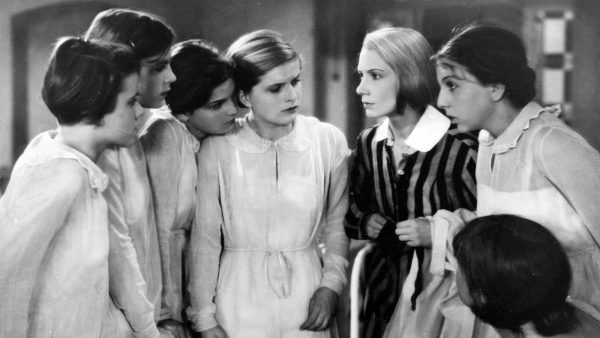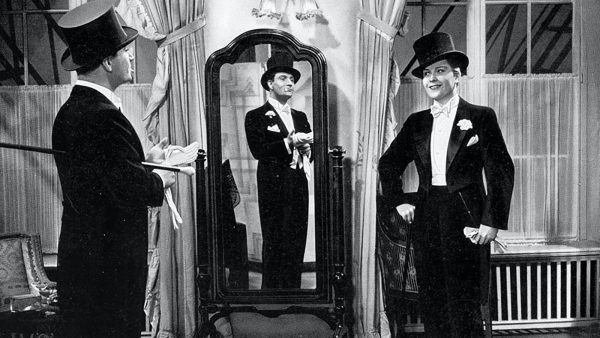Film Review: Three Early Classics of Gay Love and Desire
By Megan Sergison
It is an apt time to honor these pioneers: to recognize that we are here, and have always been here, making compelling art from under the shadow of oppression.

A scene from 1931’s Mädchen in Uniform.
Queer art has always existed. It has existed even as the world has changed, as empires have risen and fallen, in spite of censorship and persecution. It has always existed as a powerful force, offering both solace and transformation, and appearing in the most unlikely of places. The key is knowing how to look for it.
From the 15-year existence of the Weimar Republic emerged a Renaissance of German culture, producing some of the boldest pieces of German art just before Nazism swallowed the country whole. The German Expressionist movement gave us films like Metropolis and The Cabinet of Dr. Caligari, forever altering film as a medium. Look deeper, and that same period – one of ingenuity and modernism – also gave us some of the very first onscreen portrayals of gay love and desire, in all its complexity and richness. Three of these classics, Mädchen in Uniform, Michael, and Victor and Victoria, will be available — via newly restored prints (courtesy of Kino Lorber) — beginning today at the Virtual Screening Rooms of both the Coolidge Corner Theatre and the Brattle Theatre, co-presented by Wicked Queer Film Festival.

A scene from Mädchen in Uniform.
The gem of the collection is Mädchen in Uniform, a revolutionary film about 14-year old Manuela (Hertha Thiele), who, after arriving at a strict Prussian boarding school, becomes deeply infatuated with her teacher, Fräulein von Bernburg (Dorothea Wieck). Adapted from a play written by Christa Winsloe, herself a lesbian, it was saved from US censorship through the support of none other than Eleanor Roosevelt.
Mädchen in Uniform depicts lesbianism as a benediction in an otherwise unforgiving world. In the midst of hunger and austerity – common afflictions in the dying days of the Weimar Republic – von Bernburg offers Manuela and her classmates compassion and understanding. Manuela grows to yearn for von Bernburg, turning her face like a flower to her teacher’s light. Dominated by stark shadows and looming hallways, Mädchen in Uniform finds its softness in the love between women – not just in Manuela’s formative desire for von Bernburg, but between the students themselves: constantly holding hands, slinging their arms around one another’s shoulders, brushing one another’s hair, pressing their faces close together. “Verboten,” the teachers whisper. Forbidden. But love grows anyway. The film shows its tender underbelly most when Manuela pictures the Fräulein, the lines of her face softened and blurred by diffuse light, taking on the ethereal quality of a daydream. A first love, even unrealized, is a staple of LGBT cinema, and it was first charted here, all the way back in 1931. For Manuela, that first love is an awakening, something pure and good. “What you call sin,” von Bernburg insists to the draconian headmistress in the film’s climax, “I call the spirit of love.”

A scene from 1924’s Michael.
Gay love as a powerful force is turned on its head in 1924’s Michael, directed by Carl Theodor Dreyer, who would go on to helm such silent classics as The Passion of Joan of Arc. In this film, based on the 1902 novel by gay author Herman Bang, Dreyer turns his camera toward the dissolution of the relationship between wealthy painter Claude Zoret (Benjamin Christensen) and the eponymous young model (Walter Slezak). Michael, Claude’s much younger partner, is seduced by a countess (Nora Gregor), who in turn seeks to use his proximity to wealth to ease her financial burdens.
Michael is essentially a study of shifting power, especially as it pertains to the relationship between artist and muse, between youth and age. Claude, often referred to as “der Meister” (or “the master”), is demanding and strict, a true tortured artist. But when it comes to Michael he finds himself helpless. Dreyer’s camera lingers as Claude strokes his young lover’s hair, shifting from beautifully composed wide shots to shadowed close-ups as Michael drifts away from Claude and into the countess’s arms. Though their relationship is referred to as that of father and adopted son, a subplot featuring a straying wife directly parallels the triangle between Claude, Michael, and the countess, as if to underscore the homoerotic nature of the film’s main pairing. To see such a relationship between two men portrayed as early in 1924 is, in hindsight, nothing short of astonishing, even as each frame resonates with the lingering ache of betrayal and loneliness.

A scene from 1933’s Victor and Victoria.
Not all was tragedy; there is also light and joy in these early films. 1933’s Victor and Victoria revels in a spirit of freedom and playfulness as it subverts gender performance. Struggling actress Susanne (Renate Müller, in a role that would be eventually played by Julie Andrews in the English-language remake) finds herself substituting for her partner-in-crime Victor (Hermann Thimig) in his vaudeville act, in which he sings and dances as a woman named Victoria. She becomes a woman playing a man playing a woman. Once Susanne grows past her anxieties and fear of men’s changing rooms, she rockets to success, eventually landing herself and Victor in London. There, entangled in a web of affections spun among society’s finest, Susanne displays her expert slapstick mimicry of the rituals of masculinity: manspreading on a barstool, capturing the attention of a woman from across a crowded room, downing glass after glass of whiskey. Gender is dramatized as nothing more than an act, a complicated dance of carefully choreographed steps. It’s a joy to watch Müller command entire scenes with little else than her wide eyes and knack for physical comedy. Each horrified shake of her head is its own punchline. Still there is sorrow here as well, as we watch her parade around in tailored suits and sing in supposed drag. This was was the sunset of the Weimar Republic, and Müller would die under suspicious circumstances in 1937, after refusing to appear in Nazi-produced films.
Though the Weimar Republic ended as quickly as it began, and the LGBT community faced violent persecution under Nazi rule, these films survive as a testament to not only the continued existence of queer cinema, but to its vibrancy, joy, heartbreak, and power. They paved the way for future queer narratives to unfold on screen — and not just because they were made and seen. They told rich stories. Queer cinema and, to a greater extent, queer art can never be pinned down. Queer creativity contains multitudes, ranging from slow character studies to riotous musical comedies. Therein lies its strength and lasting power. As we approach another era in which fascism looms, these fascinating films remind us that the most vulnerable have always struggled to have their voices heard. It is an apt time to honor these pioneers: to recognize that we are here, and have always been here, making compelling art from under the shadow of oppression.
Megan Sergison is a writer currently based in Somerville, MA. She can be found staring out of the windows of public transportation listening to film scores, persuading anyone and everyone to watch Portrait of a Lady on Fire, or over on Twitter at @megserg.
Tagged: Carl Theodor Dreyer, Kino Lorber, Megan Sergison, Michael, Mädchen in Uniform., Victor and Victoria

Loved reading about these early LGBTQ-oriented films that I never knew existed and about a time of bold exploration as the Weimar Republic died.
Loved reading this and learning more about queer films.